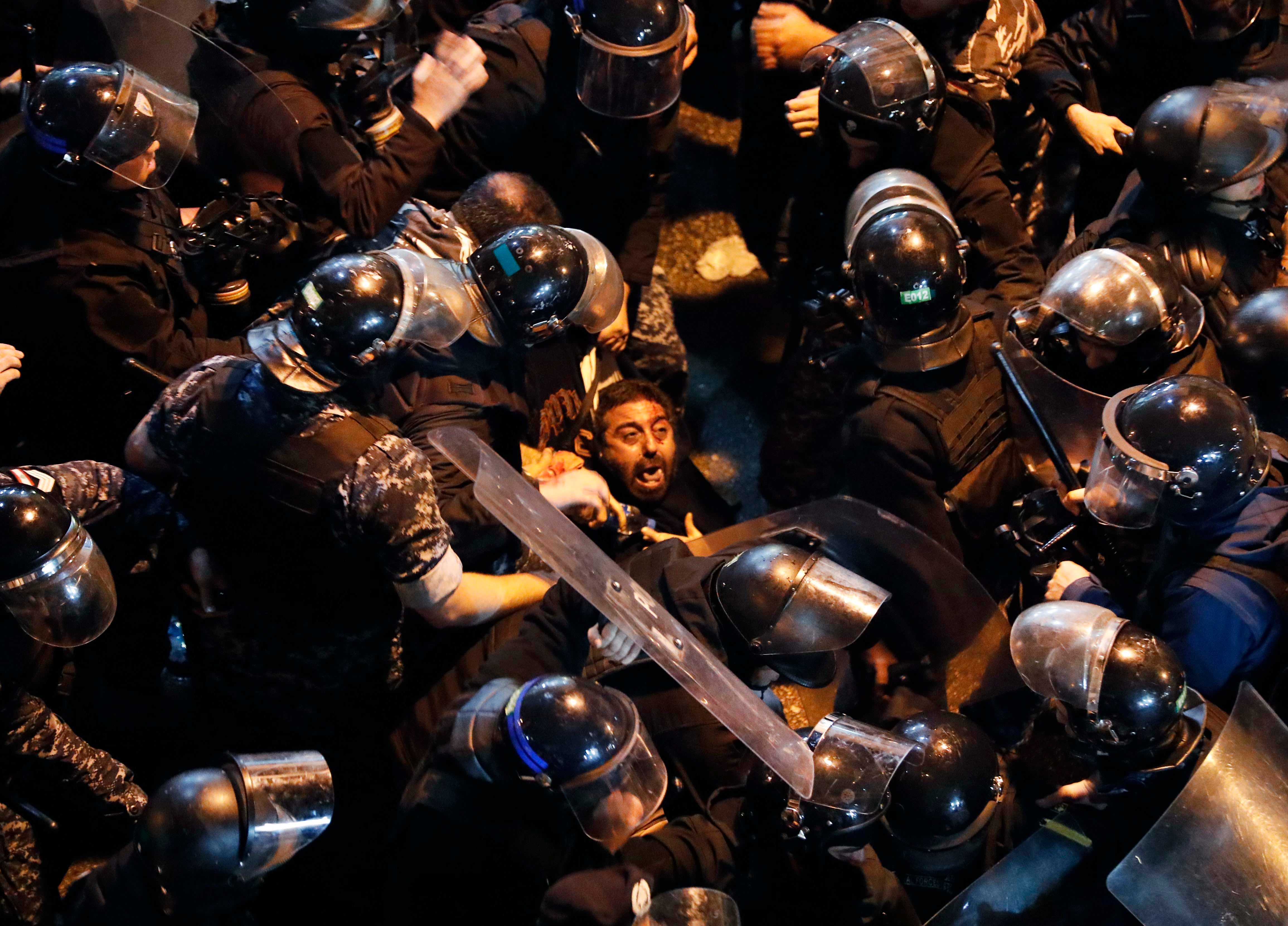Lebanon: Police Violence Against Protesters
Riot police arrest a protester outside a police station in Beirut, Lebanon on Wednesday, January 15, 2020.

(Beirut) – Lebanon’s riot police beat and violently arrested largely peaceful protesters and media workers during demonstrations on January 15, 2020, Human Rights Watch said today.
The Interior Ministry should promptly hold law enforcement officers accountable for using excessive force. Hundreds of protesters gathered in front of the El-Helou police station in Beirut on January 15 to demand the release of 57 protesters arrested during protests the previous night, some of whom had thrown water bottles and firecrackers at officers. At around 9:15 p.m., the Internal Security Force’s riot police charged onto the crowds, firing large amounts of teargas at protesters, beating some severely, and violently arresting at least 55. Riot police also beat at least eight media workers covering the protests and briefly detained three. “The unacceptable level of violence against overwhelmingly peaceful protesters on January 15 calls for a swift independent and transparent investigation,” said Joe Stork, deputy Middle East director at Human Rights Watch. “The vicious riot police attack on media workers doing their jobs is an egregious violation of security force obligations to abide by human rights standards. Human Rights Watch interviewed six protesters and three media workers who witnessed the violence and reviewed live footage of the night’s events. All six protesters asked not to be named for their protection. Throughout the day, riot police scuffled with protesters in front of the El-Helou police station. Three protesters who were there before the attack began said that the protesters were overwhelmingly peaceful although some threw water bottles and fireworks at the police. Live footage Human Rights Watch reviewed corroborates their accounts. Footage showed and witnesses said that dozens of riot police came out of the police station and began beating protesters indiscriminately and fired large quantities of teargas, driving protesters down to the residential Corniche el-Mazraa neighborhood. Live footage shows that some protesters then threw rocks at security forces and hurled teargas canisters back at them. A reporter for the local TV outlet Al Jadeed said that teargas was “raining down” on protesters in Corniche el Mazraa. Three protesters said that some riot police fired teargas directly at protesters rather than in the air. “What was especially dangerous is that they were firing teargas in a residential area,” one protester said. “I saw teargas filling up some cars, and landing on people’s balconies.” Another protester said that her friend’s house was filled with teargas. One protester said that as soon as she arrived at the scene, an officer beat her on her head and kicked her repeatedly. When she started bleeding profusely, another officer told the first one to stop.
The protester said that her neck was injured and that she needed five stitches for a cut on her head. Another protester said that she saw several riot police beating a protester who was having trouble breathing due to the teargas. A 38-year-old protester said that he saw about five officers beating a protester on the head and a girl on her neck. Human Rights Watch reviewed footage of the incident clearly showing the two protesters’ injuries. Footage also showed riot police violently arresting protesters and dragging them into the police station. A source at the Lawyers’ Committee for the Defense of Protesters told Human Rights Watch that 55 people were arrested that evening. All the Lebanese detainees were released the next day. Foreigners were transferred to General Security, the agency that deals with the entry and exit of foreigners.
The Lebanese Red Cross reported that it transported 35 people to nearby hospitals and treated 10 at the scene. A source close to Lebanon Civil Defense, a government-funded emergency medical service, told Human Rights Watch that they transported 47 people to nearby hospitals and treated 38 on site. Witnesses said that riot police attacked an MTV crew and two Al Jadeed crews while they were filming on live television.
The MTV photographer was hospitalized. A Reuters video journalist, Issam Abdallah, told the media that dozens of riot police beat him on his head with their batons and kicked him in the face, resulting in three stitches on his head. Hassan Rifai, an Al Jadeed reporter, told Human Rights Watch that around 10 p.m., a riot police officer cornered his 53-year-old cameraman, Samer al-Akdi, and hit him on his head, despite his repeated screams of “press, press.” When Rifai tried to intervene, Rifai said, the officer pushed him violently to the ground. Hassan Shaaban, a photographer for the Daily Star newspaper, told Human Rights Watch that a riot police officer yelled at him, “If you don’t stop filming, I will break the camera on your head and shove the baton up your ass.” A reporter for a regional newspaper told Human Rights Watch, “For the first time, I did not feel protected as a journalist.” Interior Minister Raya el-Hassan tweeted that she condemned the attacks on journalists and stated that accountability proceedings were already under way. She said that while the attacks are not justified, riot police were tired after being on full alert for three months.
The Internal Security Forces chief also issued an apology to journalists “for what happened to them as they covered protests on Wednesday.” Lebanese authorities should impartially investigate the use of force by riot police at the protests, and make the findings public, Human Rights Watch said. Security forces, including commanders, responsible for the use of unnecessary or excessive force should be disciplined or prosecuted as appropriate. Victims of unlawful use of force by security forces should receive prompt compensation. Authorities should release detainees not charged with a recognizable offense. “The forces responsible for maintaining law and order in Lebanon need to respect the rules on the use of force,” Stork said. “The police need to abide by international crowd control s.
Read the full article at the original website
References:
